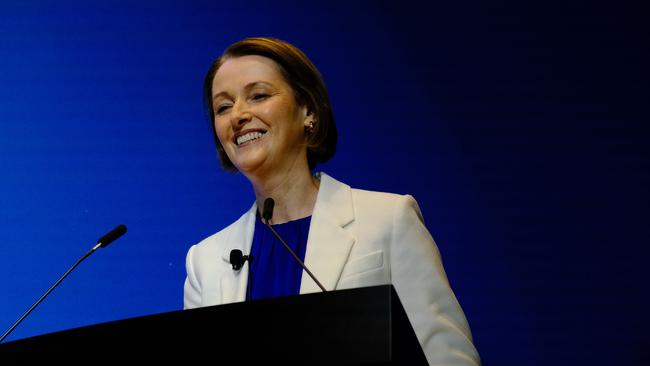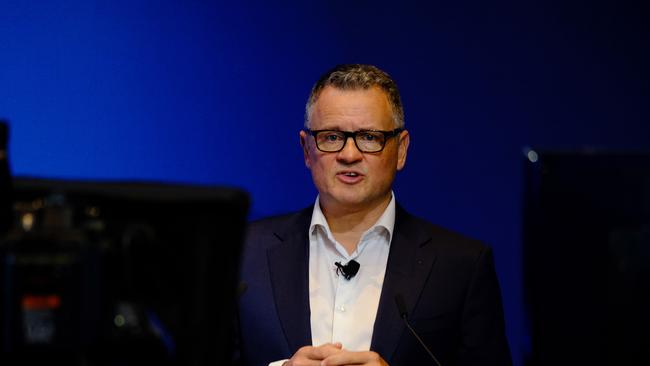Telstra’s new major routes to bring $200m per year
The nation’s largest telco will build five new major routes with its intercity connectivity project, which it says will make it a global telecommunications leader.
Business
Don't miss out on the headlines from Business. Followed categories will be added to My News.
Australia’s largest telco is betting big on becoming the lifeblood of Australian data centres, a move it estimates will bring in an additional $200m in revenue each year.
Telstra on Tuesday revealed fresh plans to increase its network, announcing thousands of kilometres of new fibre cabling which will connect capital cities across the nation as well as Asia.
The listed company revealed five new major routes which form part of its $1.6bn intercity connectivity project, which will now see 14,000km worth of fibre cable laid across the nation over the next few years.
InfraCo chief executive Brendan Riley said the plan was to “build capacity for the long-term needs of our lives, the nation, for the worlds that we live in” adding that fibre was what “underpins” all of that.
“We’re very excited about the opportunity that’s coming our way in digital infrastructure. I think probably we’re seeing that play out with the investment and utilisation that we’re particularly seeing in the data centre space,” he said. “All of those data centres need to be connected; we need to be connected; and what underpins all of that is fibre.”
Telstra told investors it had allocated $300m from the 2023 financial year to the project, with a further $300m expected to come from its FY24 revenue. The remaining $1bn will be allocated between 2025 to 2027.
The telco also announced new investment in the Pilbara, which Telstra said presents a major opportunity with $180bn worth of planned investment in the region.
About one third of the nation’s exports filter through the Pilbara, where Telstra is looking to deliver 165km of fibre to connect critical sites and facilities.
One new fibre route under construction connects Perth to Sydney then Canberra, Melbourne, Adelaide and back to Perth with two new fibre cables, one which is pink and used to connect data centres and one which is blue and used to facilitate on-ramping into regional centres.
An additional 5000km of cable is used to connect Darwin to Adelaide, Melbourne, Sydney and Brisbane, with the Sydney to Brisbane section running a coastal and in-land (express) route.
Telstra boss Vicki Brady said the investment would deliver next generation digital infrastructure for the country as demand for connectivity continued to soar.
“Connectivity will continue to play a key role in our economy and there is enormous potential for digital technologies to rewrite Australia’s growth equation,” she said.
The telco reconfirmed financial guidance for FY24, with an expected income of between $22.8bn to $24.8bn, against the prior year’s $23.2bn.

Telstra expects an underlying earnings before interest and tax, depreciation and amortisation of $8.2 to $8.4bn. Capital expenditure of $3.6 to $3.7bn is forecast.
The company’s mobile business continued to perform strongly, said chief financial officer Michael Ackland, who also acknowledged the company faced some headwinds with its enterprise business.
“Consistent with professional services activity in the market more broadly, our professional services growth and managed service performance will be less than expected. As a result, we do not expect NAS revenue and EBITDA to grow in FY24,” he said.
“In terms of phasing, we expect FY24 underlying EBITDA to be second half weighted, given timing of fixed costs, asset disposals and growth in InfraCo Fixed.”
Telstra shares closed lower on the news, ending Tuesday down 2.1 per cent at $3.87 each.
But analysts from Macquarie, Barrenjoey, Jefferies and JP Morgan labelled the stock “overweight” or a “buy”, with 12-month price targets ranging between $4.14 and $4.75.
The connectivity plans arrive as demand for data has grown exponentially, with Telstra noting a major rise in video, video streaming and monitoring, particularly from mobile devices.

Since the 2018 financial year mobile network traffic had grown 4.3 times, while fixed network traffic had grown 2.2 times.
Mr Ackland said Telstra would see a nine-year payback on its new fibre routes, which are forecast to bring an internal rate of return in the mid-teens. Telstra expects $200m per year in run rate income as services become available, around the 2025 financial year.
Telstra, which has more than 18 million customers, was “uniquely positioned” to deliver connectivity across the nation, Ms Brady said.
“As the largest investor in digital infrastructure in Australia, we are uniquely positioned to design and deliver this critical infrastructure, which will enable ultra-fast connectivity between capital cities,” she said.
“Importantly, we have future-proofed the design and given ourselves the ability to extend this connectivity into regional and remote communities as demand grows, and other partnerships arise, which will open up opportunities for regionally based industries and businesses.”
Telstra first announced its intercity fibre project in February last year, with construction beginning one month later. As of August 2022, the company had laid 400km of cable along its five priority routes, where micro stations exist every 100km to provide safety supplies, battery and solar power.
The network plan had become increasingly important as demand for cloud and AI services required lower latency and access to larger demand centres.
“This connectivity will build Australia’s fibre resiliency and support data centres that facilitate cloud and AI, remote working and education needs, health services, high-definition entertainment consumption and online gaming, and IoT use cases such as mining and agriculture,” Ms Brady said.
More Coverage
Originally published as Telstra’s new major routes to bring $200m per year





